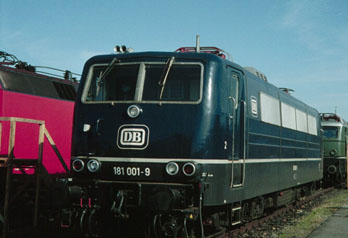E 310/E 410
E 310 / E 410
Construction
In service
E 310 / E 410
To reduce the time-consuming locomotive switch at the borders with Holland, Belgium, Luxemburg or France, the DB wanted to develop a multisystem locomotive in particular for long-distance services to the above mentioned countries. These multisystem locomotives had to stay in front of the train until the end station was reached, so exploitation was a lot easier and also costs less time.
With the experiences done with the three locomotives E 320 (BR 182), the BZA München developed together with AEG, BCC and Krupp a locomotive for two currents (E 310) and a locomotive for four currents (E 410).
 | | Multisystem locomotive BR 181 001 (E 310) in blue epoch III livery |
The two-system locomotive was suitable for 16 2/3 Hz, 15 kV AC (DB) and 50 Hz, 25 kV AC (CFL, SNCF). The four-system locomotive was besides these two currents also suitable for 1,5 kV DC (NS) and 3 kV DC (CFL, SNCB). The electrical installations in the E 410 were made in different ways so the DB could experiment with different concepts.
AEG delivered the electrical equipment for the two-system locomotives E 310 001 - 004 and for the four-system locomotives E 410 001 - 003. BCC delivered the installation for the E 410 011 and 012.
For the first time there was made use of adjustable thyristors. Also new were the pantographs SBS 65. The mechnanical parts of the locomotives was made by Krupp in Essen. All locomotives were delivered between 1966 and 1967.
With the renumbering in 1968 the locomotives class 310 were renumbered to BR 181, and the locomotives class 410 were renumbered to BR 184. The 181 003 and the 181 004 were equiped with a system which feed energy back to the catenary when the train was braking. These two locomotives were renumbered in 1969 to 181 103 and 181 104. The locomotives 184 011 and 184 012 were renumbered in the same year to 184 111 and 184 112.
So you get the following overview:
- E 310 001 BR 181 001
- E 310 002 BR 181 002
- E 310 003 BR 181 003 BR 181 103
- E 310 004 BR 181 004 BR 181 104
- E 410 001 BR 184 001
- E 410 002 BR 184 002
- E 410 003 BR 184 003
- E 410 011 BR 184 011 BR 184 111
- E 410 012 BR 184 012 BR 184 112
Due to many failures the four-system locomotives were not further developed and ordered. Also the locomotives were never in service on the routes to Holland what was initially the plan.
Construction
As far as the construction concerned both locomotive classes were identical. Only the locomotives E 310/BR 181 had two pantographs, and the locomotives E 410/BR 184 had four pantographs. Later the 184 003 had also two pantographs. The locomotive upper structure was made of three pieces. The main body rests on four flexicoil springs on the bogies. There were two springs on each bogie. All locomotives were provided with the so-called "SSW-Gummiringfederantriebe".
The electrical part of the locomotives 184 001 - 003 was based on that of the locomotives BR 181. Later the DC converters of the BR 184 were shut down. The current controlling installation of the locomotives was done by thyristors. The main transformer was in use by all sort of current.
In service
On this moment there are still two locomotives in active service, namely the BR 181 001 and the BR 184 003. Both locomotives are in services from the Bh Saarbrücken between Ehrang and Apach.
| Axle layout |
Bo'Bo' |
| In service: |
1967 |
| Diameter driving wheels: |
125 cm |
| Length: |
16,95 m |
| Top speed: |
150 km/h |
| Power: |
3240 kW at 88,5 km/h |
| Number of motors: |
4 |
| Torque: |
275 kN |
| Tension: |
15 kV ~/16 2/3 Hz
25 kV/50 Hz
BR 184: 1500/3000 V = |
| Weight: |
84 t |
|
